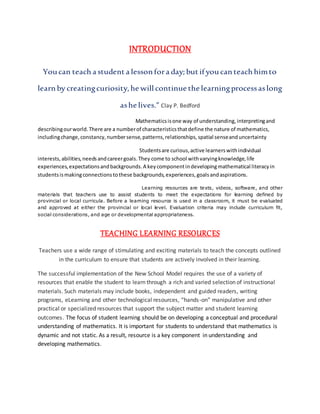The document discusses various resources that can be used to teach mathematics, including both school-based and community-based resources. School-based resources provided by the Ministry of Education include books, manipulatives, and digital resources. Community resources include places in the local area that can enhance math and science learning, such as museums. Informal resources discussed include a mathematics library, laboratory, club, and exhibitions which allow students to explore mathematics concepts freely. A variety of resources are needed to engage students in active, conceptual learning of mathematics.

![Carefully selected digital technology resources are used
to enable children to access global connections and resources while also encouraging new ways
of thinking.
Resources are classified into two they are
School basedresources
Community basedresources
SCHOOL BASEDRESOURCES
The Ministry of Education provides teaching and learning resources to schools to support the
teaching of mathematics. These include materials such as the Figure It Out series [The Figure It
Out series are mathematics curriculum support books designed to supplement classroom
mathematics programmes]. and Numeracy Booklets [The Numeracy Booklets are designed to
support the Numeracy Project].. Teacher notes are provided for both of these series and the
notes are available on the many Maths websites. As part of the Numeracy Project, schools are
able to purchase, or make, NumP kits of manipulative resources designed to support lessons in
the Number strand. These resources include: rulers, counters, dice, abacus, 100s boards,
number fans, number lines, traction squares, and animal strips.Some of the resources are given
below
Sorting& Matching](https://image.slidesharecdn.com/onlineasnmtnimmy-151118130239-lva1-app6891/85/Online-Assignment-2-320.jpg)








